Meet one of the most beautiful villages in the Marche region (and Italy). A small hilly area encloses ancient traditions, stimulating activities and great beauty.
Here’s everything you need to know about Treia, the town of the Bracelet Game.

Treia, a small ancient village in the Marche region

Dolores Prato once wrote that if Giacomo Leopardi had been from Treia, he would have felt the mystery of infinity there.
Looking out from the marble balustrade of Piazza della Repubblica, it's easy to understand the words of the Roman writer who captured the essence of the town where she spent her youth.
The village, set in a splendid landscape halfway between the Sibillini Mountains and the Adriatic Sea, is designed by a tangle of narrow streets and alleyways with magnificent Renaissance and neoclassical palaces following one another, churches guarding unexpected treasures, ancient medieval walls, Longobard towers and majestic, noble villas in the surrounding area.
Treia is a fascinating ancient world that has developed over twenty-five centuries, and it carefully tells its story to anyone who roams within its sun-kissed pavements.
Where is Treia, the town of the Bracelet Challenge

Treia is situated on a promontory overlooking the fertile valley of the Potenza River, not far from Macerata.
The historic centre is situated on a ridge at an elevation of 342 meters, offering breathtaking views that seem to stretch endlessly, with rolling hills and cultivated fields adorned with vineyards and olive trees. The sea is also within easy reach, just a half-hour drive away.
Travellers can enjoy the streets of Treia all year round, and they'll never be disappointed whether they visit in spring or autumn. Sunny days offer balconies filled with flowers and a vast expanse of green country as a backdrop to a romantic lunch on a terrace. As the weather gets colder, it's time for the enchantment of the foliage that magically covers the woods and countryside of the Marche region.
Treia is an ideal retreat to spend the loveliest days of your Italian holidays. The town is much more than the 'merely' cultural destination one would expect. In addition to learning about its history and taking part in the events held throughout the year to celebrate the local culture and specialities (we'll talk about festivals and historical re-enactments later), there are plenty of chances to enjoy the natural beauty of the surroundings and really soak in the nature of the Marche region.
Our advice? Choose from hiking trails designed for walking and trekking enthusiasts or select one of the signposted cycling routes (find the most beautiful itineraries listed here).




Treia, a fascinating history

The colours and scents of nature have always accompanied the daily life of Treia, a town on a human scale with an ancient and surprising history. Who would ever say that the cult of Isis took root in the heart of Italy? And yet, Treia's Archaeological Museum preserves artefacts of great significance that bear witness to the link that united ancient Trea to Egyptian civilisation.
The Sabines founded the first settlement along a branch of the antique Via Flaminia around 380 B.C. The Sanctuary of the Holy Crucifix complex now stands in that area.
Today's hilltop location took shape during the Middle Ages. As the barbarian incursions raged through the empire, the population sought safety on high ground, building a new town not far from the original village. Trea, whose name is a tribute to the Greek-Sicilian divinity Trea-Jana, was then renamed Montecchio (small mountain) and only returned to being known as Treia in 1790 when it acquired the title of 'city' thanks to Pope Pius VI.
Palaces, squares, churches and historic villas bear witness to a history full of anecdotes, whose events were long intertwined with those of the Papal State, of which it was part until 1860.
In spite of this bond, Treia was able to conquer flashes of autonomy, endowing itself with its own municipal system and developing a precise identity. Between the 11th and 12th centuries, an articulated defensive system was built, which included the three castles of Onglavina, Elce and Cassero and the mighty town walls.
Why Treia is famous
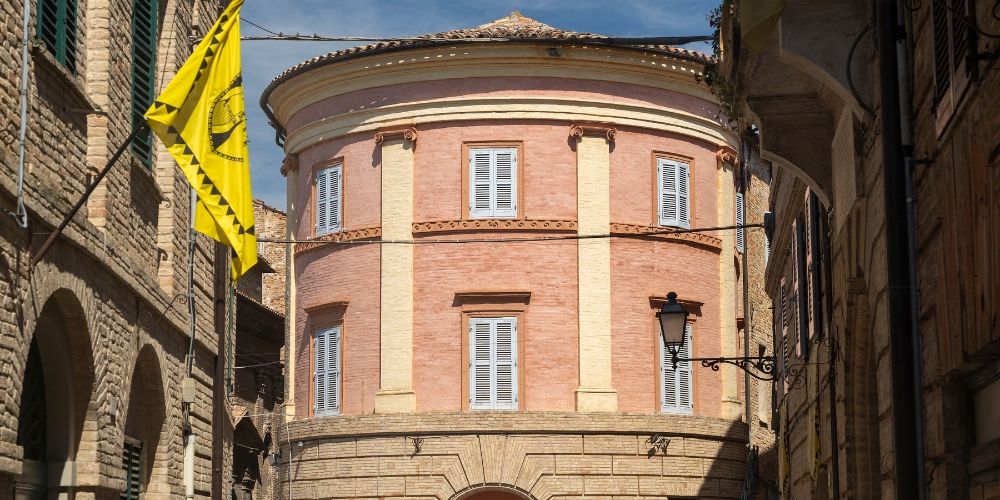
A town on the prestigious list of the Borghi più Belli d'Italia (the network listing Italy's most beautiful villages) and a place still untouched by major tourist flows, Treia is an authentic and 'lived-in' town, where souvenir shops are still scarce and locals passionately discuss their favourite sport, Pallone col Bracciale (bracelet game).
Considered one of Italy's most popular sports until the 1920s, this original Renaissance-era game is the town's pride and one of the main reasons Treia is famous.
In more recent times, Treia gained recognition thanks to Dolores Prato and her masterpiece, the autobiographical novel Giù la piazza non c’è nessuno. Published for the first time in 1980 and then released in an extended version in 1997, the book sees Treia as the backdrop and central theme of the narrative.
Centro Studi Dolores Prato, the study centre housed in the Municipal Theatre, is the key place to delve into the work of one of the 20th century's most original writers. Furthermore, Treia's iconic author has inspired a new cultural event, the 'Giù la Piazza' Festival. Launched in 2022, the initiative awards the 'Dolores Prato' Literary Prize – City of Treia to promote and highlight women's perspectives in the literary world.
Treia, the Bracelet Challenge: a unique celebration

The must-see event of the summer in Treia is undoubtedly the storied Disfida del Bracciale (Bracelet Challenge). The ancient bracelet game tournament is among the most eagerly awaited, famous and original historical re-enactments organised in Italy.
One of the best times to visit Treia is during the staging of this special event, where you can see the village going centuries back in time.
Long days of festivities involve and unite the entire town, with the four districts decked out in coats of arms, festoons and flags providing the backdrop for pleasant summer evenings in the streets, with shows, exhibitions and tastings of typical products.
Things to do in Treia

There are many things to do in Treia, both inside and outside its walls. After all, the town is very ancient, with a historic centre that holds authentic treasures. One example is the prestigious Accademia Georgica, custodian of a heritage of 14,000 volumes and a point of reference for scholars and researchers.
Among the things not to be missed in Treia is the 18th- and 19th-century collection in the Pinacoteca (Picture Gallery) and Sala degli Stemmi (Coat of Arms Room) of the Palazzo Comunale (Town Hall); the Theatre, with its magnificent historical curtain; the precious ornaments of the Church of San Filippo, including an admirable 13th-century wooden crucifix; the treasured artefacts of the Archaeological Museum, which tell of the link with the Egyptian civilisation and bear witness to the cult of Isis and Serapis practised in the Treia area.
A typical stop is the temple of the Bracelet Game, the ‘Carlo Didimi’ Sferisterio, an open-air arena built in 1818 and named after the great Treia athlete. To learn more about the history of this legendary sport, we recommend visiting the small Bracelet Museum, which houses a collection of photos, trophies, balls, and bracelets from the 19th century to the present day.
The crenellated tower of San Marco is what remains of the ancient castle of Onglavina. More than an admirable example of 12th-century military architecture, it is a magnificent balcony over the Marche region, from the Sibillini Mountains to the sea.
Things to see in Treia
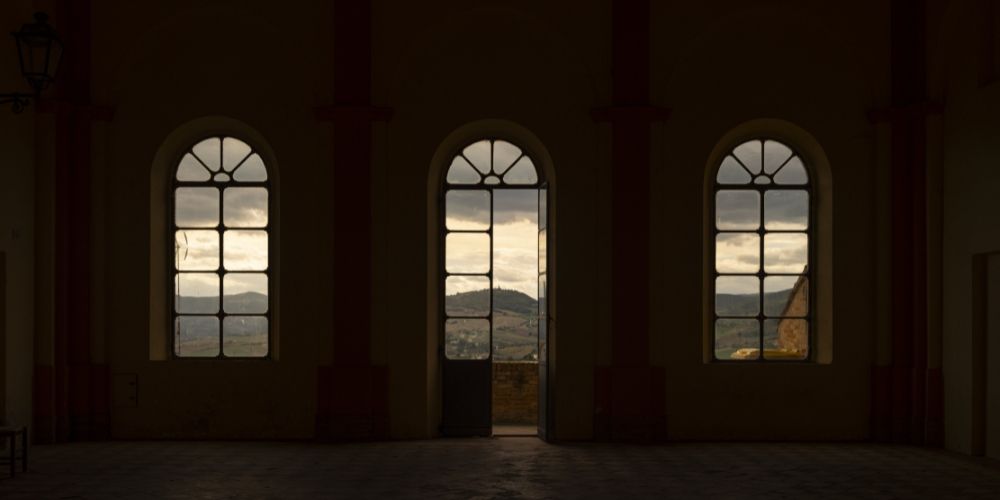
Treia is one of the Italian villages that has best preserved its history, beauty, and local traditions and with the surroundings offering many opportunities for outdoor experiences, too.
In addition to the landmarks enclosed within its walls, Treia boasts a splendid panorama of the Marche countryside (where you'll find several quality B&Bs and agriturismi, too).
Among the things to see around Treia is the medieval Torre del Mulino, a tower built to defend millstones for grinding cereals; Casa di Terra, an example of a typical 19th-century rural building constructed according to an ancient technique widespread in Abruzzo and the Marche region; splendid noble villas such as Villa Spada, by Giuseppe Valadier; and the grandiose Santuario del Santissimo Crocifisso.
A good choice of alternatives awaits those who love hiking trails and excursions in nature. You can go trekking, walk in the woods, visit places like the Abbadia di Fiastra Nature Reserve or take routes along the Potenza River.
Treia's historic centre

Treia is a town that surprises visitors with the harmony of its historic centre, which is in its own way monumental and well integrated with its surroundings. The rocky ridge on which it stands is narrow and long, so the village features a peculiar elongated shape and is protected by imposing walls.
The ideal itinerary to discover Treia begins by crossing one of the eight ancient gates: Cassera, Vallesacco, Roma, Garibaldi, Montana, San Martino, Nuova and Porta Palestro.
As you navigate the steep cobbled streets flanked by brick or stone buildings, keep an eye out for the hidden gems— a narrow alleyway, an evocative subway, a scenic stairway, or a finely worked portal. These lesser-known features, along with the most renowned monuments, contribute to the Treia's charm.
The closer you get to the town centre, the more the tour of Treia becomes focused as you meet more people, small shops and restaurants. The highlight is the elegant and scenic Piazza della Repubblica, with its spectacular marble balustrade by Andrea Vici, a pupil of Vanvitelli.
Some of Treia's most beautiful buildings stand here: the Accademia Georgica, whose façade bears the signature of Giuseppe Valadier, the beautiful colonnade of the Town Hall and the Church of San Filippo. A fine blue marble fountain and the statue of Pius VI stand right in the middle.
The churches, museums, and noble palaces of Treia open a window onto a small ancient world that speaks about the history of Le Marche and Italy. They are worth discovering.
The Archaeological Civic Museum of Treia
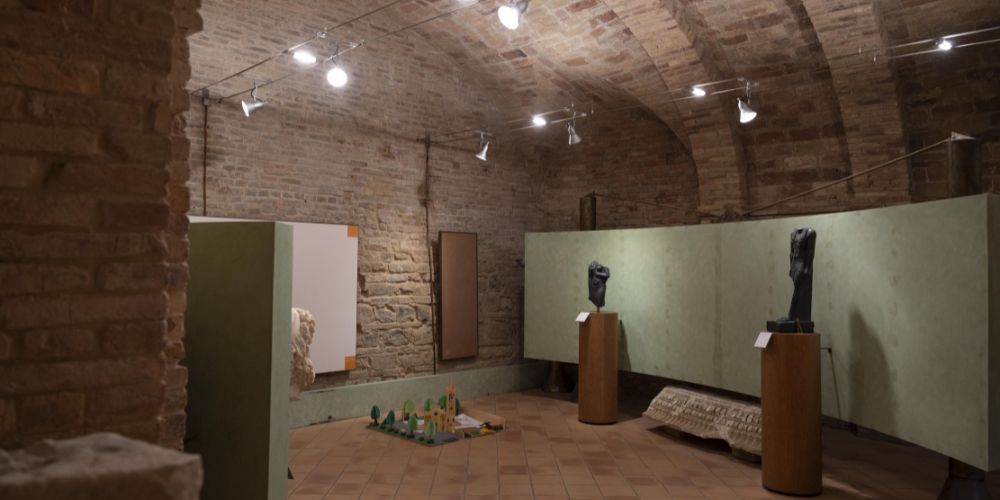
Nestled in the ancient convent of San Francesco, the Archaeological Civic Museum of Treia is a living testament to the historical ties that bound the ancient Trea to other oriental cultures, especially the Egyptian civilization.
Many of the finds that were discovered about one and a half kilometres from the town centre, in the surroundings of the Santuario del Santissimo Crocifisso. This very site is of great interest to the scientific community, as research has identified a sanctuary area dedicated to Isis and Serapis.
As a matter of fact, Treia is among the few sites revealing evidence of the worship of two Egyptian-Oriental deities from the first half of the second century AD.
Treia's Earth House
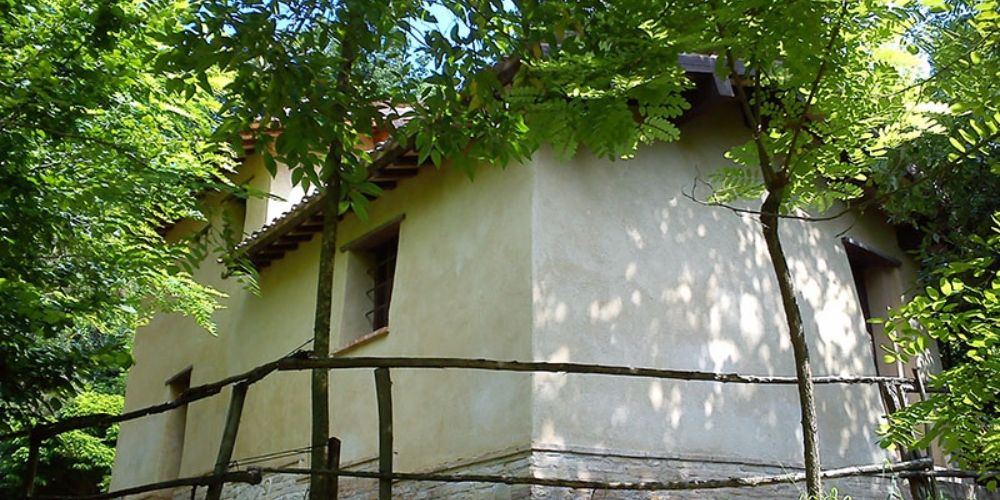
Not far from the historic centre, there is an old rural building with small and rectangular dimensions. Although the appearance may seem humble, it represents an authentic treasure of the Treia area.
Reach Contrada Fontevannazza to see the so-called Casa di Terra (house made of earth), a structure dating back to the 19th century built according to a particular construction system that used to be widespread in both the Marche and Abruzzo regions and has now practically disappeared.
The building is a rare example of a technique called massone, which involves a mixture of earth and straw and does not require the use of mortar. The walls are thicker at the base to give the structure more stability.
It is an open window into a world that no longer exists.
Teria's enchanting villas

Treia's e surroundings boasts remarkable estates and mansions that showcase the architectural heritage and noble history of the region.
Although not all of Treia's villas are always open to visitors, we invite you to take a tour in the shadow of these noble and majestic facades.
Examples include Villa Valcerasa, dating back to the 13th century; Villa Dolce Riposo, a farmhouse designed by Giuseppe Valadier; and Villa Spada, one of the most beautiful in the region.
These estates are often true masterpieces shaped by the greatest architects of the 18th and 19th centuries. Villa Votalarca, designed by Andrea Vici, even features a reconstruction of Sybil's cave in its gardens.
Treia, what to eat in a delicious destination

Treia is the perfect place to dive into the flavours and aromas of Marche cuisine. In addition to ciauscolo (a spreadable sausage typical of the region) and vincisgrassi (a kind of lasagna in the Marche style), the most famous product to try when visiting is Calcione, a gastronomic speciality prepared primarily during the Easter period.
It consists of a half-moon of puff pastry made with eggs, sugar, lemon and pecorino cheese. Baked in the oven, calcione retains a very particular flavour, sweet and salty at the same time.
It is so popular to have an entire dedicated festival held between May and June when Treia's mouth-watering speciality is present in all its forms: as an appetiser, served on a plate as a first course, as a dessert, fried...
Besides Calcione, there are many occasions in Treia to celebrate the gastronomic and cultural peculiarities of the region. Here are the ones you shouldn't miss.
Treia: all the events you can't miss
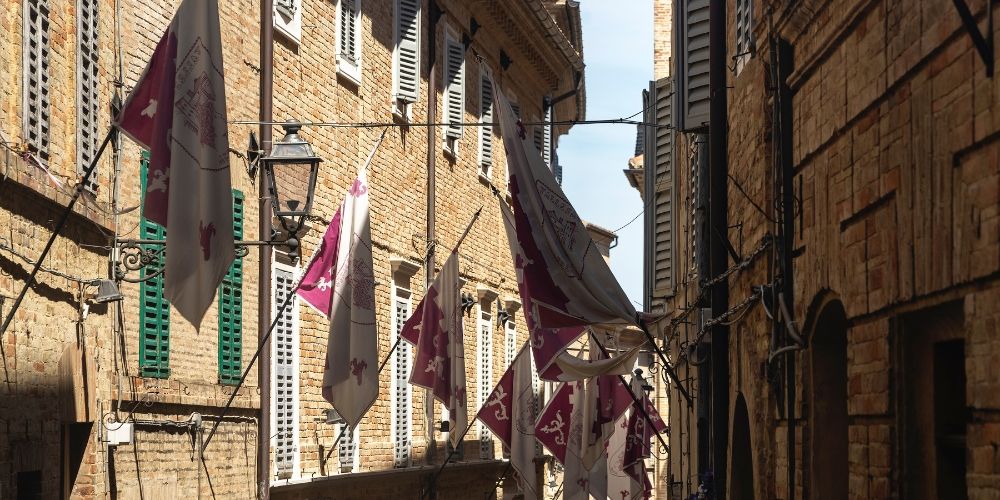
Delicious food, culture, historical reenactments, and entertainment. Treia knows how to organize festivals and events that draw large crowds.
The historic Disfida del Bracciale isn't the only event in Treia attracting visitors from all over the region (and beyond); throughout the year, numerous initiatives make this village a must-visit destination during festive days.
Let's start with food. In addition to the previously mentioned Calcione Festival held between May and June, July features Sagra del Maialino alla Brace in Camporota featuring barbecued piglets. Santa Maria in Piana hosts the Festival of Marchigiana Beef in August, and the Fermento Craft Beer Festival also occurs during this month. In September, you can attend the Sagra dei Polentari in Santa Maria in Selva, followed by the Sagra della Bio-Pizza in Passo Treia.
The flavours and beauty of the region take centre stage during the Magnalonga on May 1, a food and wine walk with seven tasting stops along a 10-kilometre route. At each stop, visitors can enjoy a traditional Marchigiano dish.
St. Patrick's Day is celebrated with a three-day festival. The celebration includes religious ceremonies, shows, concerts and the romantic 'Giardini di Marzo' initiative. Meaning 'march garden', the event brings lovely green installations to the town and transforms Treia's historic centre into a large garden.
Other significant religious events for the Treia community include the procession of Christ representation held on Good Friday.
Meetings, books, music, and walks honouring Dolore Prato: the new Giù la Piazza Festival is a culturally significant event that has garnered good attendance over its two editions.
The Soft Economy Festival features a program of talks focused on sustainability led by renowned experts in the field.
How to get to Treia

You have different options to reach Treia; the primary connections are via train (the nearest station is Macerata), bus, or your own vehicle. Let's see in detail how to do this.
When travelling by bus or train, the best way to get to Treia is to reach Macerata first and then continue by taxi or via the Contram bus line.
If you prefer to use your vehicle and want to get to Treia from the north, take the A14 Bologna-Bari motorway toward Ancona. Exit at Ancona Nord, follow the direction for Rome and exit at Jesi Centro. Drive through Filottrano and continue to Treia, following the signs.
From the south, take the A14 towards Naples and exit at Civitanova Marche. Then follow signs for Tolentino/Macerata, exit at Macerata Ovest - Sforzacosta, continue towards Macerata, cross Sforzacosta and continue towards Treia.






